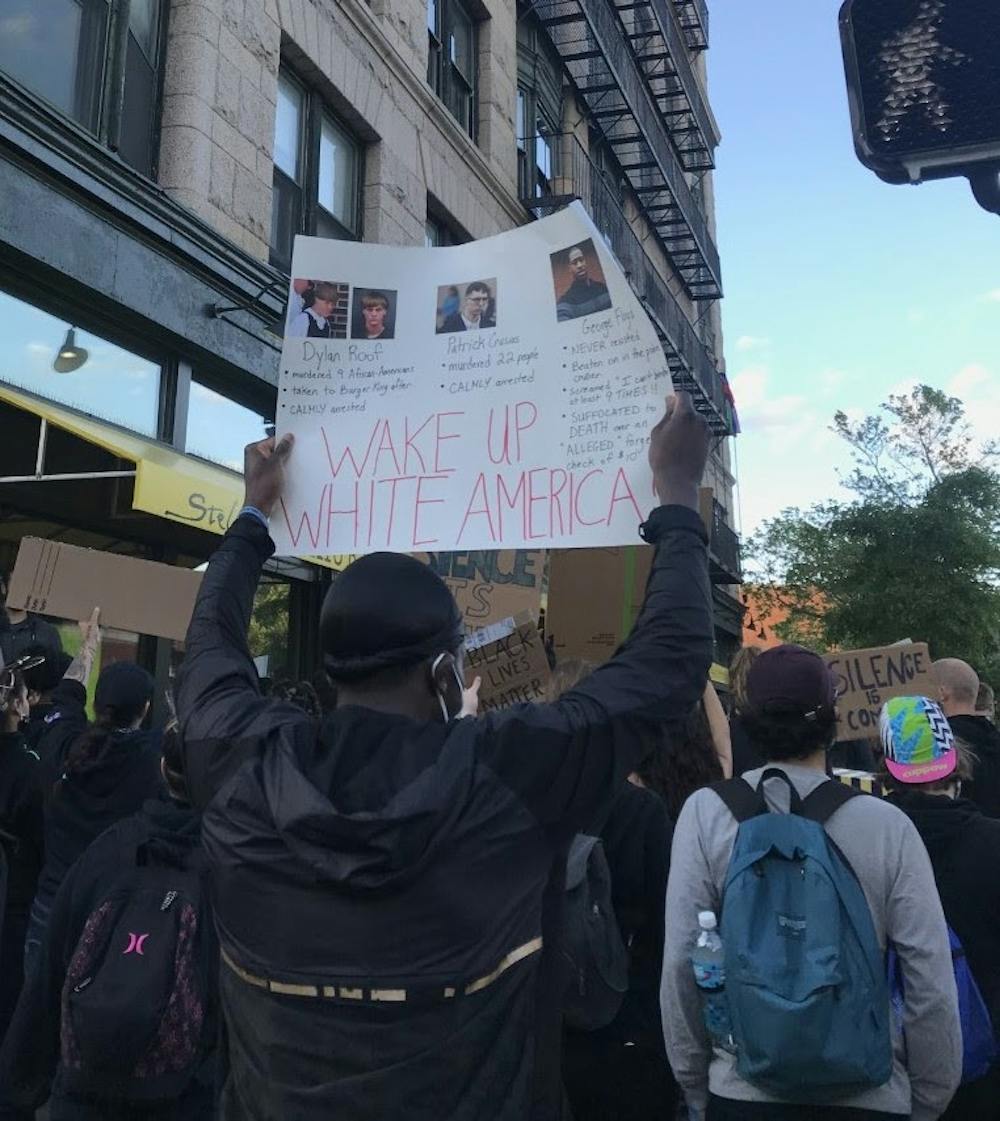Protesters have taken to the streets across the country in a national outcry against the death of George Floyd — and other Black Americans — at the hands of police. Middlebury students past and present stood at the center of many of these protests, organizing both in person and virtually to stand against police brutality and systemic racism.
For many, the recent police violence struck close to home.
“When I saw George Floyd on the ground, I wasn’t just seeing George Floyd,” said Angelina Gomes ‘23, who has attended several protests in her home city of Boston. “I was seeing a Black body. I have a Black body, My brother has a black body. My mom has a Black body. My boyfriend has a Black Body. I see these people as well.”
Based in New York City, Lazaro Galvez ’23 had already attended his fourth protest of the week when he spoke to The Campus on June 6. While protesting together on May 30, one of his friends was maced directly in the face by a police officer for allegedly getting too close to a police van. Galvez, who was standing directly beside him, dropped everything to pour water in his eyes and wipe him down.
The week has been very emotional for Galvez, who said he has repeatedly cried alone in his room. As a “White-passing Latino” growing up just outside of Harlem surrounded by Black and Brown friends, Galvez has spent the week in a near constant state of fear that his friends will attend a protest and not come back.
Maddy Stutt ‘21.5 spoke with a voice hoarse from shouting chants at the many protests she has attended in New York City. She views it as her moral obligation to attend as many protests as possible. While the crowds have remained largely peaceful, Stutt said that police have not.
Stutt winced recounting how police deployed a sonic cannon on her and other dispersing protesters Wednesday night, an experience she described as extremely painful and scary. The day before, a group of agitators followed the protesters, including Stutt. They jogged alongside the crowd, shouting racist and homophobic slurs and shoving Black men in an effort to raise tensions and incite violence, according to Stutt. As police presence increased, she and other White protesters linked arms to provide a barrier between Black and Brown protesters and police. One of the agitators stood behind the police line hurling more slurs and pushing those around Stutt to try and break through. She said the police not only failed to intervene, but many looked amused and nodded in support of the agitator.
“Every time I’ve been afraid or things have escalated it was because of the cops,” she said.
Police presence has also increased the risk of spreading Covid-19. While all of the students interviewed said that protesters had been trying to carefully manage risk by social distancing and wearing masks, several recounted incidents in which fleeing from police forced them to ignore these measures.
Kai Velazquez ‘23 helped hoist people over a fence after police left them no other escape route, coming in direct contact with other protesters. The use of tear gas and other chemicals forces people to cough, increasing the potential to spread the virus, according to Sabrina Wang ‘19.
Despite the risks, many are still committed to attending as many protests as possible.
“Injustice doesn’t have a schedule. This is not a moment where we have the option to not speak up and not say something about it,” Ian Blow ’19 said. “Yes Covid-19 cases will rise, but that doesn't invalidate how important it is that these protests are happening right now.”
Beyond providing their bodies and voices to the movement, Middlebury students past and present have donated material aid as well. Blow enlisted the help of Wang to provide supplies for protesters in New York City on May 30. The two spent six hours dashing between Duane Reade and CVS stores to buy supplies, hailing taxi cabs and running to catch the subway in a mad race to keep up with the crowd. Blow estimates that they bought between 20 and 30 cases of water along with snacks and other supplies, largely with their own money.
“The problem we are trying to solve is systems and institutions hurting lives and claiming lives,” Blow said. “The way that I wanted to combat that was to help preserve the safety of lives and make sure everyone was okay and able to protest the injustice.”
Blow later requested donations through Twitter. After partially reimbursing himself, he donated the remaining $910 to the Atlanta Solidarity Fund, which provides bail, legal advice, and access to representation for arrested protesters in Georgia. Blow plans to reprise his role this weekend with a larger group of volunteers to more effectively support the movement.
Wang said that supporting Blow, who is African American, and following his lead helped her understand her role as an ally. She plans to continue “physically and emotionally supporting Black protesters,” using her privilege to support the Black Lives Matter movement.
“These are the communities that we need to stand with as they stood with us,” Wang said. “They stood with us at the murder of Vincent Chin [and] . . . as we went through struggles in the 60s of both immigration [and discrimination]. Our Asian American movements were based on the civil rights movement, so I think it’s necessary that we stand with them now.”
Lily Laesch ‘23 has also spent the last week examining how to best support the movement as an ally. She used her social media accounts to raise money for various organizations, including the Seattle Bail Fund and Black Trans Release Fund. She estimates that she raised almost $700 in the last week alone. She plans to continue her efforts garnering support and raising funds on Instagram as well as working on a local ranch to generate income to donate herself. For Laesch, allyship is “a constant process of learning and unlearning [your own] implicit and subconscious biases and being willing to educate, not just yourself, but the people around you.”
This type of allyship, that of material aid and internal examination, is distinct from widespread virtue signaling on social media, according to Gomes and Blow. Both criticized “Blackout Tuesday,” a social media trend of predominantly White individuals posting black squares to demonstrate what they view as superficial solidarity. Many of Gomes’ former classmates at her predominately White private high school participated in this trend despite idly standing by when she and her Black peers faced blatant racism.
“White silence is violence, and they've been silent for a while now,” Gomes said. “To see them go on social media and post one black square or one thing on their [instagram] story not acknowledging their part in the violence against me and so many other people . . . feels like a spit in the face.”
Velazquez believes that real and effective allyship must start from within — educating oneself, confronting one’s own internal biases and racism, as well as confronting and educating racist family members and friends. While she has attended protests in New Jersey and New York City, she views the current turmoil as a stepping stone in what will be a long fight.
She has been inspired by Black female activists on social media, many of whom stress that it is beholden on allies to confront racism within their own homes even as they take to the streets. Velazquez has spent the last week trying to educate her family about the movement and confront what she views as rampant anti-Blackness within the Latinx community.
Speaking on the phone, she frequently paused to lower her volume so that her family wouldn't overhear. They were no longer speaking to her because she refused to drop the issue. This work has left her emotionally exhausted and distraught. Still, she views it as central to her role as an ally to her Black peers and has no plans to stop.
However, the emotional toll of protests can be particularly unbearable for Black students. Gomes described how the pervasiveness of George Floyd’s story, images of his death and footage of police violence on social media forces her to repeatedly relive the trauma of the perpetual threat of police violence to herself, her family and her peers. This anxiety exacerbates her already significant struggles with mental health and manifests physically in pervasive nausea, stomach aches, insomnia and loss of appetite.
Gomes is currently taking a brief break from attending protests and scaling back on social media over the weekend. She views this self care as a form of activism, citing the famous Audre Lorde quote, “Caring for myself is not self-indulgence, it is self-preservation — and that is an act of political warfare.”
Despite the personal risk, Gomes plans to return to the streets on Tuesday.
“I put my body on the line every time I do this. I put my mental health on the line every time I do this . . . I'm willing to risk it all," she said. “And if I'm willing to risk it all, it is to burn this whole thing down.”
Editor’s note: Lily Laesch ‘23 is an opinion editor for The Middlebury Campus.

Sophia McDermott-Hughes ’23.5 (they/them) is an editor at large.
They previously served as a news editor and senior news writer.
McDermott-Hughes is a joint Arabic and anthropology and Arabic major.
Over the summer, they worked as a general assignment reporter at Morocco World News, the main English-language paper in Morocco.
In the summer of 2021 they reported for statewide digital newspaper VTDigger, focusing on issues relating to migrant workers and immigration.
In 2018 and 2019, McDermott-Hughes worked as a reporter on the Since Parkland Project, a partnership with the Trace and the Miami Herald, which chronicled the lives of the more than 1,200 children killed by gun violence in the United States in the year since the Marjory Stoneman Douglas High School shooting in Florida.




